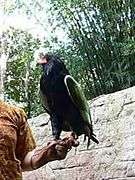Bateleur
| Bateleur | |
|---|---|
 | |
| At Maasai Mara National Reserve with a coqui francolin kill | |
| Scientific classification | |
| Kingdom: | Animalia |
| Phylum: | Chordata |
| Class: | Aves |
| Order: | Accipitriformes |
| Family: | Accipitridae |
| Subfamily: | Circaetinae |
| Genus: | Terathopius Lesson, 1830 |
| Species: | T. ecaudatus |
| Binomial name | |
| Terathopius ecaudatus (Daudin, 1800) | |
 | |
| Light green: nesting area | |
The bateleur (Terathopius ecaudatus) is a medium-sized eagle in the family Accipitridae. Its closest relatives are the snake eagles. It is the only member of the genus Terathopius and may be the origin of the "Zimbabwe Bird", national emblem of Zimbabwe.[2] It is endemic to Africa and small parts of Arabia. "Bateleur" is French for "Street Performer".[3]

Description and Behavior
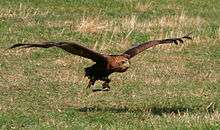
The average adult is 55 to 70 cm (22 to 28 in) long with a 186 cm (6 ft 1 in) wingspan. The wing chord averages approximately 51 cm (20 in). Adult weight is typically 2 to 2.6 kg (4 lb 7 oz to 5 lb 12 oz).[4]
The bateleur is a colourful species with a very short tail (ecaudatus is Latin for tailless) which, together with its white underwing coverts, makes it unmistakable in flight. The tail is so small the bird's legs protrude slightly beyond the tail during flight. The bateleur is sexually dimorphic; both adults have black plumage, a chestnut mantle and tail, grey shoulders, tawny wing coverts, and red facial skin, bill and legs. The female additionally has tawny secondary wing feathers. Less commonly, the mantle may be white.[5] Immature birds are brown with white dappling and have greenish facial skin. It takes them seven or eight years to reach full maturity.
The bateleur is diurnal, and hunts over a territory of approximately 250 square miles (650 km2) a day. Bateleurs are hunters and scavengers; birds such as pigeons and sandgrouse are preferred prey items, although it may attack small mammals and also takes carrion. The bateleur is generally silent, but on occasions it produces a variety of barks and screams. The bird spends a considerable amount of time on the wing, particularly in low-altitude glides.[6] "Bateleur" is French for "street performer" [3] which included performers such as tight-rope walkers. This name implies the bird’s characteristic habit of rocking its wings from side to side when gliding, as if catching its balance.
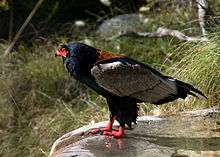
The bateleur breeds in December–March. It constructs a well-concealed nest in trees, laying a single egg which is incubated by the female for 42 to 43 days, with a further 90 to 125 days until fledging. Bateleurs pair for life, and will use the same nest for a number of years. Unpaired birds, presumably from a previous clutch, will sometimes help at the nest.
Bateleur eagles are among a group of raptors that secrete a clear, salty fluid from their nares whilst eating. According to Schmidt-Nielson's (1964) hypothesis, this is due to the general necessity for birds to use an extrarenal mechanism of salt secretion to aid water reabsorption.[7]
Distribution and Habitat
The bateleur eagle is a common to fairly common resident of the open savanna country and woodland (thornveld) within Sub-Saharan Africa; it also occurs in south-west Arabia. Total distribution size is estimated at 28,000,000 km2. The bird's range has diminished significantly in recent decades, possibly due to poisoning.[8]
Conservation
In 2009, the bateleur was placed in the near threatened IUCN Red List category due to loss of habitat, pesticides, capture for international trade and nest disturbance.[9] Decline of the species is suspected to have been moderately rapid over the past three generations. Current conservation efforts are unknown. Like the martial eagle, the bateleur is reasonably common in conservation areas and scarce elsewhere.
Global population is estimated at 10,000 to 100,000 individuals.[9]
Media
-
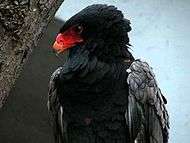
Adult
-

Adult male
-
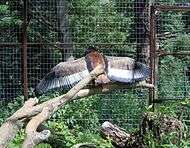
Sunwarming in a zoo
-

Immature
-
A female perched on a gloved hand in Disney's Animal Kingdom
-

Female in Texas
-
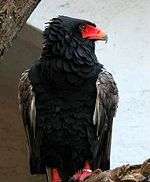
-
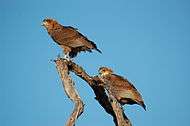
Two juveniles in Botswana
-
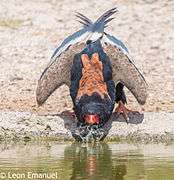
| Wikimedia Commons has media related to Terathopius ecaudatus. |
References
- ↑ BirdLife International (2012). "Terathopius ecaudatus". IUCN Red List of Threatened Species. Version 2013.2. International Union for Conservation of Nature. Retrieved 26 November 2013.
- ↑ "Zimbabwe Bird". victoriafalls-guide.net.
- 1 2 "bateleur translation English - French dictionary - Reverso". reverso.net.
- ↑ J. M. Mendelsohn, A. C. Kemp, H. C. Biggs, R. Biggs & C. J. Brown(1989) WING AREAS, WING LOADINGS AND WING SPANS OF 66 SPECIES OF AFRICAN RAPTORS Ostrich, Vol. 60, No.1, p.35-60
- ↑ Newman, K (1998) Newman's Birds of Southern Africa. Halfway House: Southern Book Publishers. ISBN 1868127680.
- ↑ Kemp, AC & Begg KS 2001. Comparison of time-activity budgets and population structure for 18 large-bird species in the Kruger National Park, South Africa. Ostrich, Vol.72, No.3-4, p.179-184
- ↑ Cade, T.J. and L. Greenwald 1964. Nasal Salt Secretion in Falconiform Birds. The Condor, Vol.68, No.4, p.338-350
- ↑ Allan, D. 1996. A Photographic Guide to Birds of Prey of Southern, Central and East Africa. Cape Town: New Holland Publishers. ISBN 1853689033.
- 1 2 Ferguson-Lees, J. and Christie, D. A. (2001) Raptors of the world. London: Christopher Helm.
External links
| ||||||||||||||||||||||||||||||

